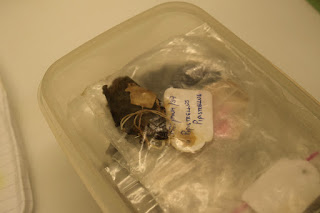The Natural History Collection of the Potteries Museum and Art Galleries is a vast collection made from 120,000 specimens from the Staffordshire region. A large part of it came from the North Staffordshire Field Club, an organization of Naturalists from the region that was founded in 1865, they published a number of books and journals studying the region´s biodiversity until 2003.
I had the chance te be shown around the collection and archives of the Potteries Museum Natural History Collection many times now. It was stepping into where the museum is most alive and where it reveals its real identity - the back stores. The Natural History collection seen on display at the Potteries Museum are about 1% of the whole collection that lies beneath - this is perhaps applicable to most museums. I have been interested in relations between nature and culture, between the sciences, and I have a great interest in discarded knowledge. One of the tasks that the Museum is currently performing is to update the entomological collections into new categorization methods within new boxes and cabinets, making it much more easier to access for researchers and also using much more efficient conservation methods and materials. I was fascinated to see the old and discarded boxes of the entomology collections. They seem to speak so much about our ways of relating to the world around us, manifesting how knowledge is as organic as the object of study. They have been very kind to give me a couple of discarded entomological boxes used for preserving and displaying and also for field collecting. So I have been using these material to produce new work. I have been working very closely with Glenn Roadley, the Museum´s Natural History curator, who has been very generous and supportive for the whole project. He has let me wonder around the collection to have an idea of what is actually there so I can understand the possibilities of our collaboration and has taught me a lot about museum´s procedures involved in the handling and use of Natural History collections. Here is a selection of images from the many visits to back stores, the next step will be bringing some specimens to AirSpace Gallery to try out new installation work.
The Natural History Back Stores
All of the broken cases are kept in cabinets
Part of the beetle collection
Death´s-head Hawkmoths: Acherontia
Dragonflies: Anisoptera
Mayfly: Ephemeroptera
Stick and leaf insects: Phasmatodea
Part of the collection of flies
Discarded entomology cases
Some very rare old victorian entomology boxes
Osteology collection
The Fungi collection
Photograph from the archives of the original displays
Tools from the entomology laboratory
Entomology Laboratory
Freezers in the Laboratory
All cases from the original bird collection
Bird collection
Original cases from the bird collection
Botanical specimens from the Herbarium
Mammal collection
Wet collection





























































No comments:
Post a Comment